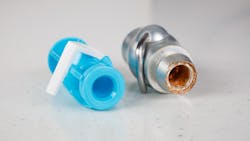Wipe out! It's time to employ single-use devices in dentistry
I love the beach. One of my favorite things to do is to head there on a warm sunny day. There is nothing like feeling the sand between my toes while watching the beautiful white-capped waves. On one of my trips, I witnessed a water rescue. A teen boy had swum out too far, with a dangerous rip current at bay. Luckily, the lifeguard brought the young man to safety. After the incident, I thought to myself how deceiving the ocean can be. The ocean may be beautiful and serene on the surface, but underneath there is the possibility of dangerous riptides and undercurrents.
This concept can be compared to our high-volume evacuation (HVE) and saliva ejector valve (SEV) maintenance. The valves are cleaned and disinfected on the surface, but what about the cleanliness of the interior? What lies beneath the exterior surface?
What lies beneath?
For dental health care professionals (DHCP), wiping exterior surfaces is part of our daily life. We are taught the two-step process, first to clean and then to disinfect. For many, this method is also used to clean and maintain our high- and low-suction valves.
When cleaning and disinfecting the operatory, the DHCP uses an Environmental Protection Agency-registered disinfectant to clean and disinfect components such as air-water syringes, dental unit attachments including saliva ejectors, and high-speed air evacuators. Per the Centers for Disease Control and Prevention (CDC), the described protocol is the standard of care for the outside of the unit.1 What about the inside of the valve? Is wiping down the unit enough?
Studies have confirmed that routine disinfection protocols (such as wiping down the unit) do not eliminate microbial contamination inside and around evacuation valves.2
The instructions for proper routine maintenance for the HVE and saliva ejector valve include the removal, disassembly, disinfection, and sterilization of the valve body. The instructions for use provide clear directions on how to care for the valves properly; however, many DHCPs do not complete this maintenance due to time constraints or lack of understanding of best practices.
The undercurrent
A further consideration regarding evacuation valves is backflow. When patients close their lips around the low-volume saliva ejector tip, a decrease in line pressure may allow previously evacuated fluid in the line to flow backward and into the patient’s mouth.3 The CDC reports a significant risk due to backflow and microbial cross-contamination between patients.1 Additionally, research suggests waterlines need additional attention due to the COVID-19 pandemic, as they may harbor virus and bacteria contaminants.4
Increasing patient safety
Moreover, the COVID-19 pandemic has increased awareness of patient safety measures. Building patient confidence has never been more important than of late. Single-use products are advantageous as they help to reduce the potential of patient-to-patient contamination.1
Dove Dental has introduced three single-use hybrid device options that overcome these valve maintenance challenges while increasing safety and efficacy:
- SE Valve: Containing one-way backflow prevention, the SE Valve is the standard valve-only version. The SE Valve will allow any standard saliva ejector to be used.
- SEPlus (SE Valve plus secured saliva ejector): The SEPlus combines the SE Valve with a secured saliva ejector. Using the SEPlus alleviates a reduced cross-contamination risk when straws come already secured in the SE Valve.
- Dove Aero (the new HVE saliva ejector with aerosol collection): This newly released device combines powerful HVE suction with a saliva ejector and reduces airborne aerosol movement by as much as 95%, according to Dove.
Dove Dental’s single-use devices provide calm in a sea of uncertainty in HVE and SEV maintenance. At a cost between $1.00 to $2.50 per unit, the products provide an economical way to alleviate inconsistent cleaning, cross-contamination risks, backflow, aerosol production, and increase safety and efficacy for your practice.
Editor’s note: This article is sponsored by Dove Dental. Content has been reviewed for editorial integrity per RDH guidelines. It was originally published in 2021 and has been updated as of May 2025.
References
- Kohn WG, Collins AS, Cleveland JL, et al. Guidelines for infection control in dental health-care settings–2003. MMWR Recomm Rep. 2003;52(RR-17):1-61
- Pine P. A case study of evacuation valves reveals hidden dangers to dental patients. RDH. November 1, 2017. Accessed January 29, 2021. https://www.rdhmag.com/patient-care/article/16409704/a-case-study-of-evacuation-valves-reveals-hidden-danger-to-dental-patients
- Boyle MA, O’Donnell MJ, Russell RJ, Galvin N, Swan J, Coleman DC. Overcoming the problem of residual microbial contamination in dental suction units left by conventional disinfection using novel single component suction handpieces in combination with automated flood disinfection. J Dent. 2015;43(10):1268-79. doi: 10.1016/j.jdent.2015.07.018.
- Amato A, Caggiano M, Amato M, Moccia G, Capunzo M, De Caro F. Infection control in dental practice during the COVID-19 pandemic. Int J Environ Res Public Health. 2020;17(13):4769. doi: 10.3390/ijerph17134769.
About the Author
Kelly Donovan, EdD, RDH
Kelly Donovan, EdD, RDH, is a dental hygiene educator, speaker, writer, mentor, and consultant. She is passionate about oral health and supporting the academic and professional development of dental hygiene students and faculty. In addition to infection control courses, Dr. Donovan presents teaching methodology courses for the dental hygiene educator specializing in instructional competency, calibration, and inclusion. She can be reached at [email protected].


